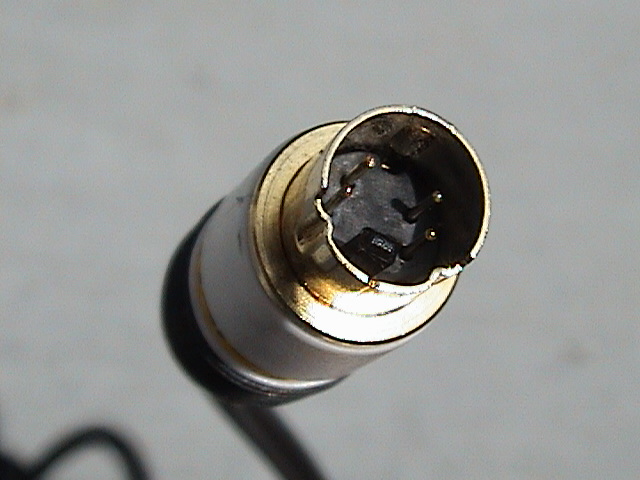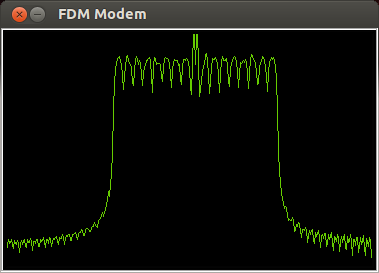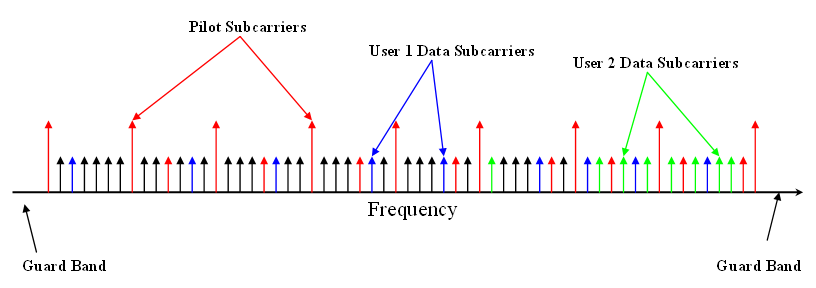|
CVBS
Composite video is an analog video signal format that carries standard-definition video (typically at 525 lines or 625 lines) as a single channel. Video information is encoded on one channel, unlike the higher-quality S-Video (two channels) and the even higher-quality component video (three or more channels). In all of these video formats, audio is carried on a separate connection. Composite video is also known by the initials CVBS for composite video baseband signal or color, video, blanking and sync, or is simply referred to as ''SD video'' for the standard-definition television signal it conveys. There are three dominant variants of composite video signals, corresponding to the analog color system used: NTSC, PAL, and SECAM. Usually composite video is carried by a yellow RCA connector, but other connections are used in professional settings. Signal components A composite video signal combines, on one wire, the video information required to recreate a color picture ... [...More Info...] [...Related Items...] OR: [Wikipedia] [Google] [Baidu] |
Composite Video
Composite video is an analog video signal format that carries standard-definition video (typically at 525 lines or 625 lines) as a single channel. Video information is encoded on one channel, unlike the higher-quality S-Video (two channels) and the even higher-quality component video (three or more channels). In all of these video formats, audio is carried on a separate connection. Composite video is also known by the initials CVBS for composite video baseband signal or color, video, blanking and sync, or is simply referred to as ''SD video'' for the standard-definition television signal it conveys. There are three dominant variants of composite video signals, corresponding to the analog color system used: NTSC, PAL, and SECAM. Usually composite video is carried by a yellow RCA connector, but other connections are used in professional settings. Signal components A composite video signal combines, on one wire, the video information required to recreate a color pic ... [...More Info...] [...Related Items...] OR: [Wikipedia] [Google] [Baidu] |
S-Video
S-Video (also known as separate video, Y/C, and erroneously Super-Video ) is an analog video signal format that carries standard-definition video, typically at 525 lines or 625 lines. It encodes video luma and chrominance on two separate channels, achieving higher image quality than composite video which encodes all video information on one channel. It also eliminates several types of visual defects such as dot crawl which commonly occur with composite video. Although it improved over composite video, S-Video has lower color resolution than component video, which is encoded over three channels. The Atari 800 was the first to introduce separate Chroma/Luma output in late 1979. However, S-Video did not get widely adopted until JVC's introduction of the S-VHS (Super-VHS) format in 1987, which is why it is sometimes incorrectly referred to as "Super-Video." Before the shift towards digital video the S-video format was widely used by consumers, but it was rarely used in profes ... [...More Info...] [...Related Items...] OR: [Wikipedia] [Google] [Baidu] |
NTSC Signal
The first American standard for analog television broadcast was developed by National Television System Committee (NTSC)National Television System Committee (1951–1953), Report and Reports of Panel No. 11, 11-A, 12–19, with Some supplementary references cited in the Reports, and the Petition for adoption of transmission standards for color television before the Federal Communications Commission, n.p., 1953], 17 v. illus., diagrs., tables. 28 cm. LC Control No.:5402138Library of Congress Online Catalog/ref> in 1941. In 1961, it was assigned the designation CCIR System M, System M. In 1953, a second NTSC standard was adopted, which allowed for color television broadcast compatible with the existing stock of black-and-white receivers. It is one of three major color formats for analog television, the others being PAL and SECAM. NTSC color is usually associated with the System M. The only other broadcast television system to use NTSC color was the System J. Since the introduct ... [...More Info...] [...Related Items...] OR: [Wikipedia] [Google] [Baidu] |
NTSC
The first American standard for analog television broadcast was developed by National Television System Committee (NTSC)National Television System Committee (1951–1953), Report and Reports of Panel No. 11, 11-A, 12–19, with Some supplementary references cited in the Reports, and the Petition for adoption of transmission standards for color television before the Federal Communications Commission, n.p., 1953], 17 v. illus., diagrs., tables. 28 cm. LC Control No.:5402138Library of Congress Online Catalog/ref> in 1941. In 1961, it was assigned the designation CCIR System M, System M. In 1953, a second NTSC standard was adopted, which allowed for color television broadcast compatible with the existing stock of black-and-white receivers. It is one of three major color formats for analog television, the others being PAL and SECAM. NTSC color is usually associated with the System M. The only other broadcast television system to use NTSC color was the System J. Since the intr ... [...More Info...] [...Related Items...] OR: [Wikipedia] [Google] [Baidu] |
Comb Filter
In signal processing, a comb filter is a filter implemented by adding a delayed version of a signal to itself, causing constructive and destructive interference. The frequency response of a comb filter consists of a series of regularly spaced notches in between regularly spaced ''peaks'' (sometimes called ''teeth'') giving the appearance of a comb. Applications Comb filters are employed in a variety of signal processing applications, including: * Cascaded integrator–comb (CIC) filters, commonly used for anti-aliasing during interpolation and decimation operations that change the sample rate of a discrete-time system. * 2D and 3D comb filters implemented in hardware (and occasionally software) in PAL and NTSC analog television decoders, reduce artifacts such as dot crawl. * Audio signal processing, including delay, flanging, physical modelling synthesis and digital waveguide synthesis. If the delay is set to a few milliseconds, a comb filter can model the effect o ... [...More Info...] [...Related Items...] OR: [Wikipedia] [Google] [Baidu] |
Frequency Spectrum
The power spectrum S_(f) of a time series x(t) describes the distribution of power into frequency components composing that signal. According to Fourier analysis, any physical signal can be decomposed into a number of discrete frequencies, or a spectrum of frequencies over a continuous range. The statistical average of a certain signal or sort of signal (including noise) as analyzed in terms of its frequency content, is called its spectrum. When the energy of the signal is concentrated around a finite time interval, especially if its total energy is finite, one may compute the energy spectral density. More commonly used is the power spectral density (or simply power spectrum), which applies to signals existing over ''all'' time, or over a time period large enough (especially in relation to the duration of a measurement) that it could as well have been over an infinite time interval. The power spectral density (PSD) then refers to the spectral energy distribution that would ... [...More Info...] [...Related Items...] OR: [Wikipedia] [Google] [Baidu] |
Harmonic
A harmonic is a wave with a frequency that is a positive integer multiple of the '' fundamental frequency'', the frequency of the original periodic signal, such as a sinusoidal wave. The original signal is also called the ''1st harmonic'', the other harmonics are known as ''higher harmonics''. As all harmonics are periodic at the fundamental frequency, the sum of harmonics is also periodic at that frequency. The set of harmonics forms a '' harmonic series''. The term is employed in various disciplines, including music, physics, acoustics, electronic power transmission, radio technology, and other fields. For example, if the fundamental frequency is 50 Hz, a common AC power supply frequency, the frequencies of the first three higher harmonics are 100 Hz (2nd harmonic), 150 Hz (3rd harmonic), 200 Hz (4th harmonic) and any addition of waves with these frequencies is periodic at 50 Hz. In music, harmonics are used on string instruments and wind in ... [...More Info...] [...Related Items...] OR: [Wikipedia] [Google] [Baidu] |
Luma (video)
In video, luma represents the brightness in an image (the "black-and-white" or achromatic portion of the image). Luma is typically paired with chrominance. Luma represents the achromatic image, while the chroma components represent the color information. Converting R′G′B′ sources (such as the output of a three-CCD camera) into luma and chroma allows for chroma subsampling: because human vision has finer spatial sensitivity to luminance ("black and white") differences than chromatic differences, video systems can store and transmit chromatic information at lower resolution, optimizing perceived detail at a particular bandwidth. Luma versus relative luminance Luma is the weighted sum of gamma-compressed R′G′B′ components of a color video—the ''prime symbols'' ′ denote gamma compression. The word was proposed to prevent confusion between luma as implemented in video engineering and relative luminance as used in color science (i.e. as defined by CIE). Relative ... [...More Info...] [...Related Items...] OR: [Wikipedia] [Google] [Baidu] |
Chrominance
Chrominance (''chroma'' or ''C'' for short) is the signal used in video systems to convey the color information of the picture (see YUV color model), separately from the accompanying luma signal (or Y' for short). Chrominance is usually represented as two color-difference components: U = B′ − Y′ (blue − luma) and V = R′ − Y′ (red − luma). Each of these difference components may have scale factors and offsets applied to it, as specified by the applicable video standard. In composite video signals, the U and V signals modulate a color subcarrier signal, and the result is referred to as the chrominance signal; the phase and amplitude of this modulated chrominance signal correspond approximately to the hue and saturation of the color. In digital-video and still-image color spaces such as Y′CbCr, the luma and chrominance components are digital sample values. Separating RGB color signals into luma ... [...More Info...] [...Related Items...] OR: [Wikipedia] [Google] [Baidu] |
Frequency-division Multiplexing
In telecommunications, frequency-division multiplexing (FDM) is a technique by which the total bandwidth available in a communication medium is divided into a series of non-overlapping frequency bands, each of which is used to carry a separate signal. This allows a single transmission medium such as a microwave radio link, cable or optical fiber to be shared by multiple independent signals. Another use is to carry separate serial bits or segments of a higher rate signal in parallel. The most common example of frequency-division multiplexing is radio and television broadcasting, in which multiple radio signals at different frequencies pass through the air at the same time. Another example is cable television, in which many television channels are carried simultaneously on a single cable. FDM is also used by telephone systems to transmit multiple telephone calls through high capacity trunklines, communications satellites to transmit multiple channels of data on uplink and down ... [...More Info...] [...Related Items...] OR: [Wikipedia] [Google] [Baidu] |
Subcarrier
A subcarrier is a sideband of a radio frequency carrier wave, which is modulated to send additional information. Examples include the provision of colour in a black and white television system or the provision of stereo in a monophonic radio broadcast. There is no physical difference between a carrier and a subcarrier; the "sub" implies that it has been derived from a carrier, which has been amplitude modulated by a steady signal and has a constant frequency relation to it. FM stereo Stereo broadcasting is made possible by using a subcarrier on FM radio stations, which takes the left channel and "subtracts" the right channel from it — essentially by hooking up the right-channel wires backward (reversing polarity) and then joining left and reversed-right. The result is modulated with suppressed carrier AM, more correctly called sum and difference modulation or SDM, at 38 kHz in the FM signal, which is joined at 2% modulation with the mono left+right audio (which r ... [...More Info...] [...Related Items...] OR: [Wikipedia] [Google] [Baidu] |







